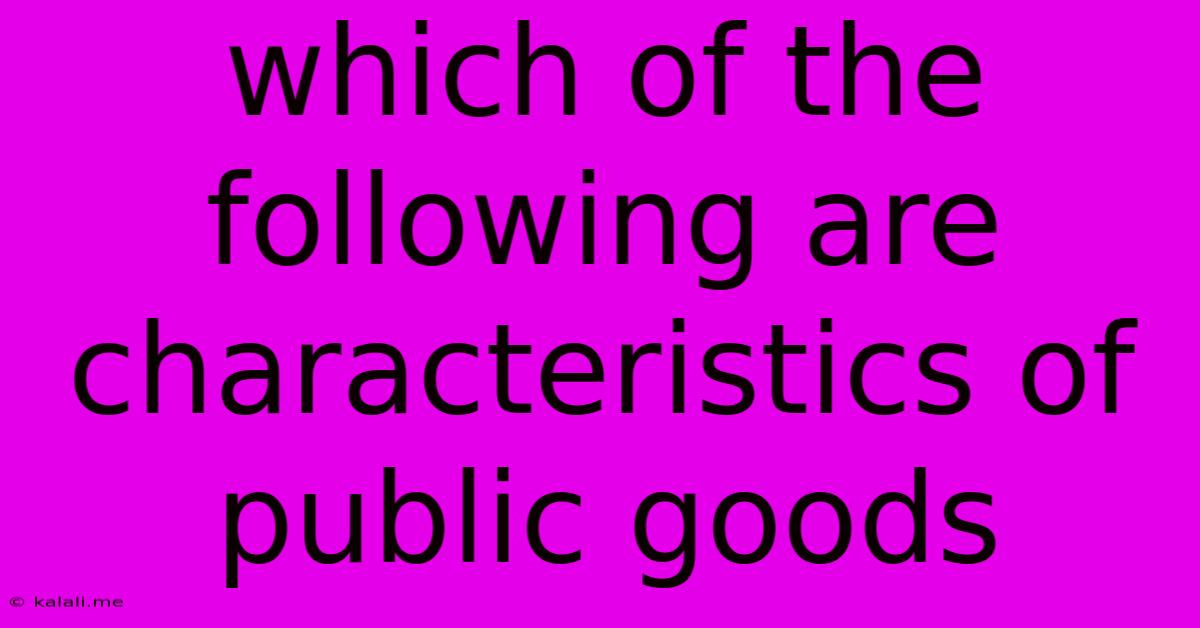Which Of The Following Are Characteristics Of Public Goods
Kalali
Jun 15, 2025 · 3 min read

Table of Contents
Which of the Following Are Characteristics of Public Goods?
Public goods are a fascinating area of economics, often misunderstood and easily confused with other types of goods. Understanding their defining characteristics is crucial for effective policymaking and resource allocation. This article will delve into the key features that distinguish public goods, helping you discern them from private goods and common resources.
Meta Description: Learn to identify public goods! This guide explains the defining characteristics of public goods, differentiating them from private goods and common resources with clear examples. Master the concepts of non-excludability and non-rivalry.
Public goods are characterized by two main properties: non-excludability and non-rivalry. Let's break these down:
1. Non-Excludability
Non-excludability means that it is impossible or extremely difficult to prevent individuals from consuming a good, even if they don't pay for it. Once the good is provided, it's nearly impossible to stop anyone from benefiting. Think about national defense: you can't exclude people from the protection offered simply because they haven't paid taxes. This contrasts sharply with private goods like a slice of pizza; if you don't pay, you don't get to eat it.
Examples of non-excludability:
- National defense: Protection from external threats is provided to everyone within a country's borders, regardless of their individual contribution.
- Clean air: While regulations aim to improve air quality, it's difficult to prevent everyone from breathing the air, regardless of their efforts in environmental protection.
- Street lighting: Anyone can benefit from street lighting, regardless of whether they contributed to its installation and maintenance.
2. Non-rivalry
Non-rivalry implies that one person's consumption of the good does not diminish another person's ability to consume it. My enjoyment of national defense doesn't reduce your enjoyment of it. This is different from rivalrous goods like a slice of pizza; if I eat it, you can't.
Examples of non-rivalry:
- Public parks: One person using a park doesn't reduce the ability of others to use it simultaneously (unless it's overcrowded, a point we'll address below).
- Radio broadcasts: Many people can listen to the same radio broadcast without diminishing each other's enjoyment.
- Knowledge (in certain contexts): The sharing of knowledge, like a scientific discovery, benefits multiple people without diminishing its value for others.
The Free-Rider Problem
The combination of non-excludability and non-rivalry leads to the free-rider problem. Because people can benefit from a public good without paying, they have an incentive to do so. This can lead to under-provision of public goods because private markets struggle to provide them profitably. This is why governments often step in to provide public goods, funding them through taxation.
Important Considerations and Exceptions
While the definitions of non-excludability and non-rivalry are clear-cut in theory, the real world is more nuanced. Congestion can create rivalry in goods that are otherwise non-rivalrous. For example, a public park can become rivalrous if it's overcrowded. Similarly, technological advancements can sometimes make goods that were previously non-excludable, excludable (e.g., pay-per-view television).
Identifying Public Goods: A Checklist
To determine if something is a public good, ask yourself these questions:
- Can I prevent someone from consuming this good, even if they don't pay? (Excludability)
- Does my consumption of this good reduce someone else's ability to consume it? (Rivalry)
If the answer to both questions is "no," you're likely dealing with a public good.
By understanding the characteristics of public goods – non-excludability and non-rivalry – we can better grasp the challenges involved in their provision and the importance of governmental intervention in ensuring their availability for the benefit of society.
Latest Posts
Latest Posts
-
What Is The Value Of 1 4
Jun 16, 2025
-
Which Of The Following Attack Compromises Confidentiality Choose Two Options
Jun 16, 2025
-
According To The Law Of Supply When Prices Increases
Jun 16, 2025
-
How Many Diagonals Does A Nonagon Have
Jun 16, 2025
-
Lcm Of 2 And 3 And 6
Jun 16, 2025
Related Post
Thank you for visiting our website which covers about Which Of The Following Are Characteristics Of Public Goods . We hope the information provided has been useful to you. Feel free to contact us if you have any questions or need further assistance. See you next time and don't miss to bookmark.